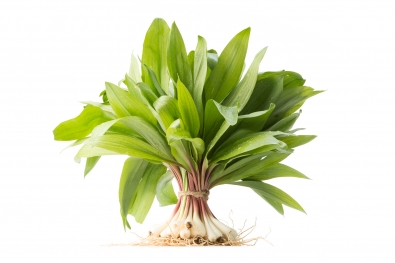Recipes – № 55
Ramp Pesto
I’ve been experimenting with ramp pestos this spring and have settled on this recipe as my favorite. It’s addictive and very simple. Most ramp pestos have you blanching the ramp greens and combining them with a bit of raw garlic. Just as in the basil-based summertime classic, the garlic provides the necessary structure and depth. I’ve found that this approach mutes the ramps however. Why not leave out the garlic and make use of the uncooked ramps’ own garlicky heat? The result is a full-flavored spring pesto that ends your taste buds’ hibernation with a bang. Serve it with pasta or any mild-flavored poultry or meat such as chicken or pork.

Makes about 1 ¼ cups, enough for 1 lb of dried pasta (4-6 main course portions)
3 oz young ramps (leaves, stems and bulbs). Around 10 ramps. Should be about 2.5 oz trimmed and cleaned.
1/3 cup pine nuts (or just about any other nuts, pumpkin seeds or sunflower seeds)
1/3 cup grated Parmesan (loosely packed)
1.5 to 2 Tbsp lemon juice (from about half a lemon)
¾ cup olive oil
¾ tsp fine sea salt
Equipment: Large mortar and pestle

Heat a small saucepan over low heat. Add the pine nuts and toast briefly while shaking the pan frequently. Once the nuts begin to brown and become fragrant, immediately remove them from the pan and set aside. Left in the pan, the nuts will quickly burn, even away from the heat.
Trim, wash and finely chop the ramps. Grind in the mortar and pestle with the salt until the plant fibers are broken and the juices are released. Add the pine nuts and grind until all the nuts are broken up but before the mixture turns into an even smooth paste. Add the Parmesan and 1.5 Tbsp of the lemon juice and grind a little more to combine. Incorporate the olive oil into the mixture gradually while continuing to use the mortar and pestle. If you’re planning to use the pesto as a poultry or meat sauce, stop short of the entire ¾ cups of olive oil since you’ll want it on the thicker side. Taste for salt and lemon juice. Cover the pesto with some more olive oil to prevent it from oxidizing and browning. Keep in the fridge until used.
Making ramp pesto with a blender:
The word pesto is derived from the Italian word for pounding or crushing (as in a mortar and pestle) and it’s true that you can’t get that perfect crumbly consistency using a blender. If you don’t have a large mortar and pestle however, then the blender is your best option. To adapt this recipe to the blender, place the chopped ramps, toasted pine nuts, grated Parmesan, 1.5 Tbsp of the lemon juice and the salt in the blender. Operate the blender in short intervals while adding the olive oil gradually. Don’t run the blender for too long or you will loose the last bit of that appealing crumbliness.


Add a comment